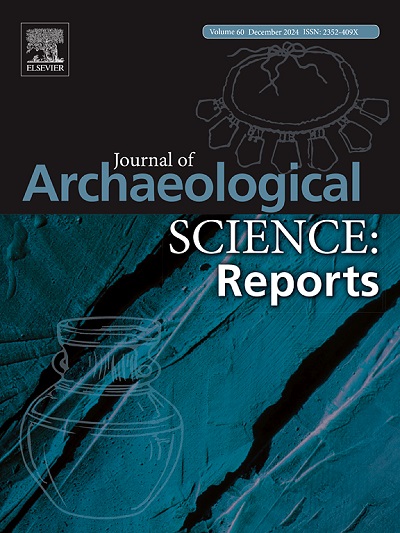奎瓦尔火山的印加孩子:稳定同位素为地理起源和季节性饮食提供线索,并推测食用海藻
IF 1.5
2区 历史学
0 ARCHAEOLOGY
引用次数: 0
摘要
印加人在公元 1438 年至 1532 年间占领了南美洲西海岸。他们举行的许多仪式中包括卡帕科查仪式,其中包括献祭儿童。在这里,我们研究了在阿根廷萨尔塔的奎瓦尔火山上发现的一具儿童木乃伊。为了确定孩子的地理来源并了解其作为祭品之前的生活习惯,我们逐步测量了一根头发丝中角蛋白的δ13C、δ15N、δ34S 和δ2H 值,以及一根肋骨中磷灰石磷酸盐的δ18O 值。虽然孩子的来源仍不确定,但从肋骨成分推断出的饮用水氧同位素组成表明,孩子的来源地在海拔 2,500 至 3,000 米之间,与安第斯山脉接壤。此外,在头发中测量到的正弦δ2H 信号与当地季节性降水变化的记录相符。结果表明,孩子在死前没有移动或只是短暂移动。正如头发中的δ2H 值所显示的那样,这次献祭可能发生在雨季(夏季)开始的时候。结合毛发中的δ13C、δ15N和δ34S测量值,我们还提出了一个最合理的假设,即海藻占食物的一部分(16.2 ± 12.9 %),在雨季(夏季)达到食用高峰。本文章由计算机程序翻译,如有差异,请以英文原文为准。
The Inca child of the Quehuar volcano: Stable isotopes clue to geographic origin and seasonal diet, with putative seaweed consumption
The Incas occupied the west coast of South America between 1438 and 1532 CE. Among the many rites they practised was the Capacocha, which involved the offering of children. Here we studied the mummy of a child found on the Quehuar volcano, Salta, Argentina. In order to determine the geographical origin of the child and to understand the living habits prior to its presentation as an offering, we incrementally measured the δ13C, δ15N, δ34S and δ2H values of keratin from a hair strand and the δ18O value of apatite phosphate from a rib bone. Although the origin of the child remains uncertain, the oxygen isotope composition of the drinking water deduced from the rib composition argues for an origin between 2,500 and 3,000 m.a.s.l. bordering the Andes. Furthermore, the sinusoidal δ2H signal measured in hair is compatible with the recording of local seasonal precipitation variations. The results indicate that the child did not move or moved only briefly prior to death. This offering may have occurred at the onset of the wet season (summer), as suggested by the hair δ2H values. By combining δ13C, δ15N and δ34S measurements in hair, we also proposed as the most parsimonious hypothesis that seaweed constituted a proportion (16.2 ± 12.9 %) of the diet, with a peak of consumption during the wet season (summer).
求助全文
通过发布文献求助,成功后即可免费获取论文全文。
去求助
来源期刊

Journal of Archaeological Science-Reports
ARCHAEOLOGY-
CiteScore
3.10
自引率
12.50%
发文量
405
期刊介绍:
Journal of Archaeological Science: Reports is aimed at archaeologists and scientists engaged with the application of scientific techniques and methodologies to all areas of archaeology. The journal focuses on the results of the application of scientific methods to archaeological problems and debates. It will provide a forum for reviews and scientific debate of issues in scientific archaeology and their impact in the wider subject. Journal of Archaeological Science: Reports will publish papers of excellent archaeological science, with regional or wider interest. This will include case studies, reviews and short papers where an established scientific technique sheds light on archaeological questions and debates.
 求助内容:
求助内容: 应助结果提醒方式:
应助结果提醒方式:


